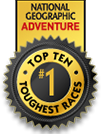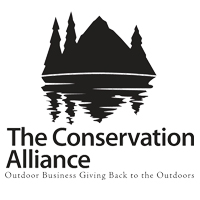Excerpt From “Over The Edge”
A Regular’s Guy’s Odyssey in Extreme Sports
To The Edge
It is 10 degrees below zero outside my tent, and it has been snowing steadily for three days. I keep trying to think of new, inventive ways of keeping warm, but, ultimately, they all boil down to just one-stay in my purple sleeping bag as long as I can, try to will my mind to blankness.
The wind roars, and the tent pops like a piece of rawhide on the end of Indiana Jones’ bullwhip.
It is, I think, Indiana Jones who has gotten me into this. At least, he’s got to be partially responsible. Him and his keyword, “adventure/.”
In a few minutes, I will have to crawl out of my marginally warm sleeping bag, punch a hole up, through the snow, crawl out and start digging out of my tent. Welcome to Denali, Mt. McKinley, Alaska, Land of Adventure. I have come to this undefrosted refrigerator of a land to check an item off a list. No, make that, The List. Thirteen items, activities, events that have come to define the outer limits of my life; heck, the outer limits of any life.
It is an over the edge list, a collection of events that nightmares are made of:
Trapped in underwater caves…
Trapped on a frozen waterfall…
Trapped in Death Valley…
Trapped in Alcatraz…
And now, trapped on the highest mountain in North America, pinned in by a brutal blizzard and temperatures almost beyond comprehension.
“Wind chill? How about real damn cold?”
I twist into as much of a ball as you can twist into in a mummy sleeping bag, avoiding the inevitable.
I am not supposed to be here…
I am in my 40s, well past the derring-do years. I am a couch potato; well, maybe I was a couch potato. But I know, emphatically, I am not supposed to die in a blizzard on this mountain.
Or am I?
I first created the list with some friends over pizza and beer after a particularly knarly day of windsurfing in Florida. The next morning, on the desk in my office, lay a cocktail napkin with 13 items scrawled across it.
I thought to myself, suppose I really did the list? No, The List, upper case. Suppose I really did it? How crazy is this stuff, anyway? Who are the people who think these things are fun?
I mean, it’s easy to understand why a person might want to run three miles; harder to understand what drivez a person to train to run almost 150 miles across one of the most godforsaken spots in the world, where the asphalt, I will learn, is hot enough to cause the air pockets in the runners’ sneakers to explode and the final 13 miles of climbing will bring them from scorching heat to cold approaching freezing.
It’s easy to understand the urge to swim a couple of times a week for fitness at the local “Y”; harder to grasp the dark appeal of the Alcatraz swim, the bitter cold waters sluicing in and out of San Francisco Bay, the fog and swirling currents, the real or imagined torpedo-like shapes patrolling the deep channels.
So I come to the risk sports looking, I think, for Indiana Jones. Or, at least, someone like him. Some part and parcel of our mythology, cowboy or samurai, riding the edge jaggies for all they’re worth.
Instead, I will find a group of puzzled people wit a tiger by the tail, interested not so much in mythology as in touching and holding an experience as ephemeral as spider silk, ghostly as morning mist over a Montana river, an experience made of equal parts muscle, adrenaline, and a mind that echoes a sneaker commercial…just do it…do it…do it. An experience I touched, however briefly, on a piece of fiberglass in a windy yacht basin.
“I think I know where you’re going,” one of my many instructors will tell me as we hike along the frozen waterfalls of New Hampshire’s Frankenstein Cliffs, named not for Mary Shelley’s monster, but for an artist. The temperature will be below zero, and the winds from the valley below will scour the ice, turning it as brittle and fragile as an old window pane. “But how do you plan on getting back?”
But that is still a ways in the future; out of sight; out of reach.
I stare at my cocktail napkin.
Why not? How hard can it be?
I spend an afternoon at the library, looking up events. There is precious little hard information. I can turn on the television and see all manner of this stuff, but hard information is lacking. The more I search, the more extreme sports seems to be terra incognito, the place on the map where there’s nothing but a hand-drawn dragon. There are secrets here, I think, a world over the edge of the map. Secrets…
I go back to my office and stare at my cocktail napkin:
- Windsurf Big Air.
- Kamikaze Downhill
- Escape From Alcatraz
- Whitewater off a Waterfall
- Rock Climb
- Cave Dive
- Ice Climb
- Skydive; whatever those parachuting thingies are.
- Skate Marathon
- Dive Really Deep
- Badwater Death Valley Run
- Iditarod Bike Race
- Denali
I need a plan. At first, the plan seems easy-I’ll scrape up what money I have, go out to Death Valley and tan onto that nightmarish run. Then I’ll head on up north to do the Kamikaze Downhill. I’ll learn to rock climb, then mountain climb and get certified to SCUBA dive while I’m at it. I’ll even learn to swim, something I’ve been avoiding. The wind howls, and nothing seems impossible. I drive home, clean my equipment, take a handful of aspirin, shower, and bandage my hands. Then I get the morning paper and turn to the classified—I’m going to need a mountain bike, I think…
Chapter 5
Hanging Out In Death Valley
The first clash with reality comes when the rubber meets the road, or, more honestly, when the sneakers meet the dirt. I am methodically (and painfully) turning myself into the slowest runner in the world. Train though I might, in the end, I suspect running will have the upper hand. Still, it’s a necessary step, I grudgingly admit, if I am ever going to get anywhere. I can see the edge, and it seems off at the edge of the horizon.
This obsession with running is triggered by the first contact between The List and the obstacles. I have decided, for reasons that are not totally clear to me, that the Death Valley run, Item 11, would be a good starting point to get me out in training and into doing. It takes me a couple of weeks of phone calls to find out anything about that Death Valley race, which turns out to be the Hi-Tec Badwater 145-miler, sponsored by a sneaker company, Hi-Tec. I learn this from an ad in an old magazine someone loans me, which is a font of information. I learn, for example, that the race, 145 miles of living hell, across Death Valley, over two mountain ranges and up the highest peak in the continental U.S., was created to promote a trail running sneaker, which is no longer being manufactured. Upon seeing a picture of the sneaker, I understand why it is no longer being manufactured. In a world of sleek, high fashion athletic shoes, the Badwater sneaker is butt ugly.
I call the toll-free number listed on the old ad, and eventually end up talking to Dave Pompel, the genial Hi-Tec exec who handles the race. Can I, I ask, just jump in and run the next race, which happens to be a few months away?
“No,” Pompel says.
“Why not?”
“Because,” he continues, “this is one of the hardest running races in the world, and—correct me if I’m wrong—you don’t strike me as being an elite ultramarathon runner.”
Well, I reply, there’s something to that.
“Also, the race requires a sag wagon carrying your water and medical support,” he says. “I don’t suppose you have a sag wagon lined up?”
Well, I say, not exactly.
I think about the situation for about a minute while Pompel patiently waits. I need to do something, or The List is going to die before it even gets started.
“Can I come watch?” I hear myself asking.
“By all means,” says Pompel. “And bring a bicycle.”
Perfect!
I have already purchased a battered mountain bike from the classified ads, which I’m going to use in the Kamikaze Downhill. Death Valley, two mountain ranges and the climb up Mt. Whitney ought to get the kinks worked out of the bike.
“I’ll be there, ” I say. “Death Valley in July sounds wonderful.”
“Bring water,” Pompel adds. “And lots and lots of sunscreen.”
The cheapest airfare is into Reno, which is, of course, nowhere near Death Valley. Nonetheless, my bicycle and I arrive in the ratty gambling town late at night, where we pick up the rental and head through the relentless neon into the cool dark of the desert. I camp out in a cowboy motif motel near the desert town of Lone Pine, and head into Death Valley the next morning.
Did I mention the heat?
By 10 a.m. it is skillet-hot, the whole world taking on the smell of glowing iron, while the temperature of the rental car climbs perilously into the red. I look at the first rising hills, and I realize that the air conditioner, never perhaps an optimum piece of machinery, wouldn’t make the climb. I shut if off and roll down the windows.
There is only one radio station I can find as I creep into the blistering mountains, and the disc jockey is performing an on-air exorcism on one of Satan’s minions, a 16-year-old fan of Dungeons and Dragons.
“I want,” the announcer shouts, “to speak to the demon! Speak to me, demon!”
The boy makes a choking noise. “I can’t!” he screams, although it comes out something like, “Ah caned! Ah caned!”
Suddenly, the boy’s voice changes.
“Damn you!” the boy shouts in a new voice. “Damn you and your Jesus!”
Amazingly, the announcer cuts to a commercial for Diet Coke. The car is moving about 10 miles per hour up the steep grade. Every few miles there’s an iron water tank for overheated radiators, and the rising heat creates a twisted carnival mirror affect. The distant mountains dance and twist, and I wonder how far we are from the Charles Manson homestead.
“We now join live, on the air, a battle for a man’s soul,” the radio announcer is whispering, breathlessly. “There’s some rough language, but, people, we are dealing with Satan himself, right now, live!”
We creep on.
“Was Satan, Beelzebub, the Beast Himself that made you kill those little animals, wasn’t it! Wasn’t it!”
“Damn you! Damn you! Damn You!”
I am beginning to wonder whether this is such a great idea after all when we top the last hill and I see the long roller coaster ride into Death Valley proper. It looks…hot.
I roll on through the desert, past ghost towns and moving sand dunes, until I come to a sign that reads: “Ahead—Dates!”
After hours of steady exorcism, the idea of a date in Death Valley is a little frightening. Date palms, of course—the oasis in the middle of the desert. When I arrive, the place strikes me as hell’s own Holiday Inn, a flashy stone building resort surrounded by date palms. There’s even a pool, filled with German and Japanese tourists who appear to have all been dipped in the last existing batch of Red Dye #2. Welcome to Furnace Creek, and pass the sunscreen. This is race headquarters.
“Be gone, demon! Back to The Pit! Be gone!”
When I shut off the ticking, clanking car, the demon is still hanging on, but I sense it’s a close thing.
I check in, stow the bike in my room, and head for the mandatory prerace meeting. There are 15 entrants this year, and for the privilege of running across the desert and up assorted mountains, each entrant will receive a plastic water bottle and a t-shirt. Finishers will receive the coveted Badwater belt buckle.
The race is simplicity itself. At 6 p.m. tomorrow, the contestants will travel the few miles to Badwater, at 282 feet below sea level, the lowest point in the United States. It’s called Badwater because there is, in fact, a pool of water there, so laced with alkalis of various sorts that it’s a nasty, poisonous chemical stew. Badwater is south, deep into the valley, past the Devil’s Golf Course, in the shadow of 11,000 foot Telescope Peak.
The temperature at the race start will be around 125 degrees. Six feet above the blistering, shimmering asphalt—roughly at head level—the temperature will be closer to 160. “Last year,” one of the racers chortles, “some peoples’ air pockets in their sneakers blew up!” The runners will head north onto U.S. 190, the main two-lane blacktop that carves across this Road Warrior landscape. The runners will pass Furnace Creek, heading toward Stovepipe Wells, a wide spot in the road on the edge of the great migrating sand dunes.
With luck, the runners will hit the first of the mountain ranges, the Panamints, around dawn. They’ll creep up the road I coasted down, headed toward 5,000 foot Towne Pass, where they’ll have a relatively straight shot down into the brilliant salt flats of the Panamint Valley. The runners will have another climb into the tail end of the Inyo Mountains, before heading down onto the long, flat stretch into Lone Pine and the entrance to Mt. Whitney. The run to the entrance to the Mt. Whitney park is 13 miles, with almost a 9000 foot elevation gain. At the portals, the clock stops, and the race formally ends, because the Park Service doesn’t allow races to be run on public land. Most runners, though, Pompel confides, will continue informally to the top of Mt. Whitney, elevation 14,494 feet. The temperature at the portals will probably be in the 40s, although it could easily dip to below freezing. Snow is a possibility.
There is no water on the course, no medical care available, no food and supplies for the hottest part of the run. There is also a 60-hour time limit. The fastest runner will hit the portals in under 30 hours.
“Is this a great race, or what?” says Pompel.
I have decided to follow, mostly, Marshall Ulrich, a 30-something Colorado runner who has made the race his own. When I call his business to let him know I’m coming, his secretary tells me he’s not in.
“He’s out running across the state,” she says without a trace of irony. “He’ll be back in a few days.”
When Marshall and I finally meet, he is what one would expect from a person who thinks running across a state—any state—is fun—thin, wiry and intense. He takes me aside to tell me his finely honed strategy for the race.”If I can run flat seven-minute miles for the first 35 miles, it’ll get me through the hottest part of the run with a minimum amount of contact between my feet and the pavement,” he confides.
Makes sense, I say. I have run a seven-minute mile—exactly one seven-minute mile, and then I had to lay down on the track. I am beginning to think very kindly of Dave Pompel’s foresight.
I meet some of the other racers—a rodeo cowboy turned banker turned ultramarathoner, a phys ed teacher whose husband “gave” her this race as a wedding present, a doctor who has just finished the Markleeville Death Race bicycle ride, and whose support crew will carry a coffin filled with ice, a lawn chair and an inflatable palm tree, plus a square of Astroturf for the lawn.
“Be gone, demon! Back to The Pit! Be gone!”
Early the next morning, just as a cotton candy pink dawn is touching the Funeral Mountains, I get up, slip on my shorts, t-shirt and running shoes, fill a water bottle with the warm, salty water from the tap and head down the road, toward Badwater. The thermometer by the pool reads a paltry 85 degrees when I start running, but I know as soon as the sun clears the Funerals the temperature will click up faster than a New York City taxicab meter.
I run along the sandy shoulder of the road, the only sound in the desert is my sneakers, crunching sand. The heat is dry, brittle, like a long spell of fever or crumbling old parchment. I imagine the greedy atmosphere leeching the water from my pores, moisture vanishing before it even has a chance to become sweat.
The desert is still, digging itself in for the hellish day to come. The only plant I can definitely identify is the dried arms of Death Valley sage, unique to this corner of the earth. I follow the pavement until a turnoff onto a gravel road. I head down the gravel, deeper into the desert. The sun is beginning to make itself felt; half its blazing diameter is visible now above the Funerals. All across the gravel road are the twisted hieroglyphics left by the sidewinder rattlesnakes in the gritty sand. An hour passes, then another half hour. I finally stop, the sun blistering on my face. I’ve left the road and run up a jeep trail, which eventually dead-ends into a little box canyon. The snake tracks are thick across the floor of the little canyon, as if all the rattlers on the right hand side decided to exchange places with all the rattlers on the left hand side. I am sincerely glad I wasn’t around when the word came to change sides. It is quiet and still, and all the people in the world are gone. I sit on an already warming rock and sip my tepid water, then run back the way I came, my treaded footprints overlaying the hieroglyphics. It is like running through a microwave oven.
Before the race start, I walk down to the murky pool at Badwater. The edges of the pool are crusted with white mineral deposits, and beneath the surface of the hot, deadly water, creatures dart. Life is persistent. Above us, high on the rocks, someone has painted “282 feet below sea level,” to be sure we don’t forget. Strangely, the next time I’m this far below sea level, I won’t be breathing air. But that’s to come.
My plan for observing the race is simple—I’ll ride my bike along with the runners, run some when I can. Get as close to the race as possible, the least I can do for The List. At 6 p.m., when the runners head off, the temperature is around 120 degrees.
I ride the first 26 miles—the first marathon—on my mountain bike, keeping tabs on Marshall, who is running effortless seven-minute miles, then drifting to the back of the pack, to talk to the doctor with the coffin. At one point, I pull a water bottle off the bike’s down tube and proceed to spray 160-degree water into my face. Note to myself: Carry water on person; 98.6 degrees is substantially less than 160 degrees.
Watching a running race, though, is a little like watching paint dry, and once the full chill of the desert evening sets in, I ride the two hours back to the car, with about a billion stars to light the way. Feeling vaguely guilty, I go back to my hotel room and sleep for four or five hours.
By dawn, Marshall is through the mountains. I drop back, and eventually pick up the rodeo cowboy turned banker, who’s hiking his way up the steepest inclines.
“Want company?” I ask, and he nods. I’m able to drop my bike with the lone support vehicle, cruising up and down the lonely highway, and join him.
“You know what the strangest thing about races like this is?” he asks.
Other than the very fact of their existence, I reply, I don’t have a clue.
“It’s the changes you go through,” he begins. Then we walk along comfortably for a bit.
“In something like this, where you’re being pushed to the mental and physical limits,” he says. “Strange things happen to your brain. It’s like every emotion you’ve ever had—love, hate, fear, anger, all of them—at one time or another out here, they all come out.”
He talks on as we walk, steadily uphill.
The thing is, he is saying, you can’t pay attention to those emotions, either the good ones or the bad ones.
“They’re like thunderstorms in the desert,” he says. “there’s big noise and flashes and the trees shake and the wind blows like stink, but it passes. It passes. And what you’ve got to do is stand there and let those storms blow past.”
We walk awhile in companionable silence. Then he tells me about the rodeo, about his family, about running, about the endless string of miles that have somehow come to define his life. “I think about that a lot while I’m out here,” he says. “But heck, I think about everything.”
Later, I ride for hours, up and down the increasingly spread out line. I am riding uphill, singing to myself, in the full heat of midday. My body is completely covered, except for my face, which is layered with sunscreen the consistency of tar. I pull up my shirt sleeve to scratch my arm, and I notice that I have apparently been dusted with flour.
Salt, I think. The moisture is leeched away, leaving the salt.
I continue my singing and peddling until my brain belatedly engages.
I shouldn’t feel so good bicycling uphill in 120 degree heat. Ergo, I am on the verge of heatstroke.
I stop peddling, lean the bike against a convenient boulder and force myself to drink a full water bottle of hot, metallic-tasting water. In no time at all, I am rewarded with a splitting headache. Since I no longer feel like singing, I get back on the bike and start riding again. The seat is hot enough to sear my butt through the layers, and the metal of the handlebars is too hot to touch.
In the evening, right about full dark, one of the sag wagons for a woman runner flags me down. “Run with her,” one of her team says. “She needs some company.”
So we load my bike into the sag wagon, and they drop me alongside the Phys-Ed Teacher, then leap-frog miles ahead to the next stop.
The first few miles are what you’d expect, comparing notes on homes and families and training regimens. She and her new husband have spent hours and hours on the road, sneakers joined together in holy matrimony, and this race is his gift to her. She is very happy. But the miles wear on, and the hour is late.
Every emotion, the rodeo cowboy, now far ahead, told me. Every one.
“You know my husband, right?” the Phys-Ed Teacher asks, abruptly, and there’s an edge on her voice. It’s after midnight in Death Valley, and there are still 90 miles of running left. The temperature has finally dropped below 100 degrees. “I hate him,” she continues. “No, I want him to die. That’s worse than hating him, isn’t it?” I tell her I think wanting someone to die is worse than hating them.
“Well, that’s what I want. I want him fucking dead.”
She runs for a while in silence, and I can imagine her teeth grinding in the dark.
“I hate this,” she says, and she is crying.
Time passes; the sound of sneakers; occasionally, in the distance, the cry of a night hunter.
“I have to sleep,” she says.
I know, I say, soon.
The miles and the night pass.
I run into her the next day, after she’d grabbed a few hours sleep in a real bed in a place called Panamint Springs. She squints at me through eyes that have seen a little too much nuclear sunlight.
“Did we run together last night?” she asks.
“For a while.”
“Anything I say that sounded stupid,” she says, “was the desert talking.”
“Never thought otherwise.”
Later, I zoom ahead to walk alongside Marshall up Mt. Whitney. He has been running for more than 24 hours with a total of 45 minutes sleep. He is haggard, destroyed, a haint, my granddaddy would say, methodically placing one foot in front of the other, up the mountain. At one point, his support crew is worried that he doesn’t have enough fuel left to make it to the top. They decide on chocolate, M&Ms, and tell him to eat. But Marshall, at least the thinking, rational, laughing Marshall, is no longer home. He continues plodding up the mountain.
One of the crew puts a handful of the brightly colored candy in his right hand and rolls it into a fist. But the fist loosens, and the M&Ms dribble onto the ground.Finally, his main support person puts a half-dozen M&Ms in his hand.
“Marshall,” she says firmly. “Put the candy in your mouth.”
He does so, without taking his eyes off the road ahead of him.
“Chew it,” she says.
His jaws begin to work.
“Now swallow it.”
He gulps.
It is the most agonizing performance I have ever seen.
Twenty-nine hours after leaving Badwater, he arrives at the portals, accepts the congratulations and goes to sleep. A few hours later, he gets up and runs to the top of Mt. Whitney and back down, setting an unofficial record.
I won’t cheat again, I think, the desert rolling beneath the rental’s wheel. I won’t stand by and watch again. The only way to be fair to The List is to do, not watch. Whatever it takes.
End of Chapter Five, Over The Edge, by Michael Bane
Michael Bane’s career reads like a novel—and a very unlikely novel at that.
In more than 20 years of professional journalism, Bane has journeyed from the cocktail parties of New York celebrity journalism, to small wars in the Third World, to the executive boardrooms of some of the most successful companies in American and, most recently, to the ends of the earth in search of adventure.
His trips and stories have been chronicled in such magazines as Men’s Journal, Men’s Fitness, National Geographic Adventure, Esquire and literally hundreds of others. His 19th book, Over The Edge: A Regular Guy’s Odyssey In Extreme Sports (released in 2000 in paperback by Wilderness Press), prompted the Wall Street Journal to ask…”How did Michael Bane become the George Plimpton from hell?”
Michael Bane has spent time as a confidant to country music superstars, an authority on world class performance in large corporations, a black belt in karate, a columnist and consultant on personal computers, a dedicated restorer of vintage Norton motorcycles, a “guest terrorist” for the U.S. Army Ranger battalion at Ft. Benning, GA, an expert competition shooter and editor of numerous magazines on topics as varied as beer and self-esteem.
He’s been a ghost for various country music singers—Living Proof, the Hank Williams Jr. story, went on to become a top-ten television movie as well as a successful book.
His book on the complex relationship between music, culture and race (White Boy Singing The Blues, originally published in the late 1970s and reissued by Da Capo Press in 1992) recently received this review from an academic journal: “The genuinely eerie aspect about Bane’s study is his ability to conjure the Southerner’s perspective of mystery, fear, danger and suspicion that continues to shroud race relations in the United States…This book matches the very best analyses of rock music ever produced.”
Bane’s co-authored book on business management, Shifting Paradigms (Dogwood, 1991), was cited by business magazines as a significant contribution and is quoted in the Arthur Andersen Group’s recent compendium on current American management thinking.
As a speaker, Bane has addressed audiences in the United States and Canada on topics of risk and risk management, as well as functioning in chaos systems. In October, Bane will be one of four Americans speaking at a special business conference in Bangkok, Thailand, which will be Webcast along the Pacific Rim.








